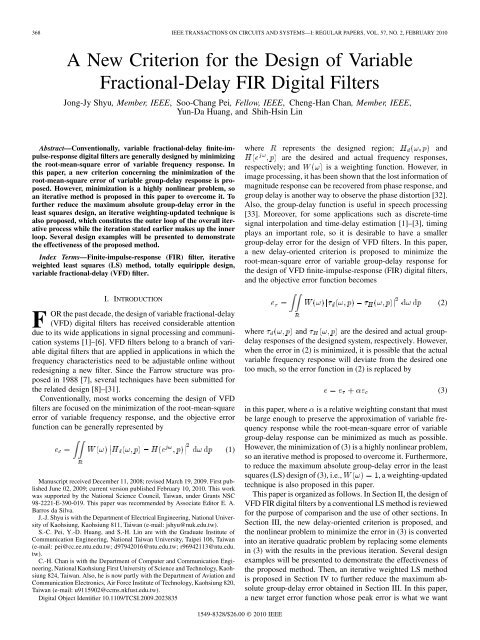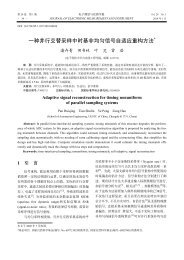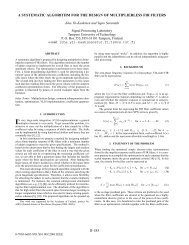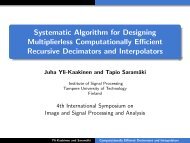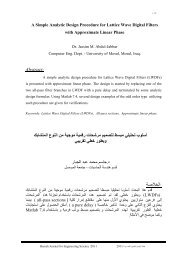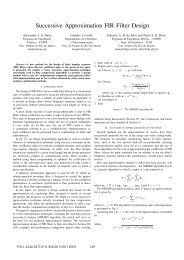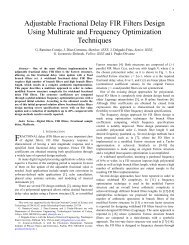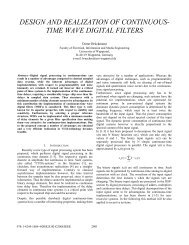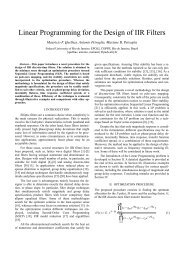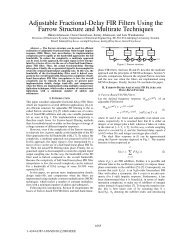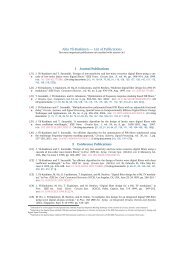A New Criterion for the Design of Variable Fractional ... - IEEE Xplore
A New Criterion for the Design of Variable Fractional ... - IEEE Xplore
A New Criterion for the Design of Variable Fractional ... - IEEE Xplore
Create successful ePaper yourself
Turn your PDF publications into a flip-book with our unique Google optimized e-Paper software.
368 <strong>IEEE</strong> TRANSACTIONS ON CIRCUITS AND SYSTEMS—I: REGULAR PAPERS, VOL. 57, NO. 2, FEBRUARY 2010A <strong>New</strong> <strong>Criterion</strong> <strong>for</strong> <strong>the</strong> <strong>Design</strong> <strong>of</strong> <strong>Variable</strong><strong>Fractional</strong>-Delay FIR Digital FiltersJong-Jy Shyu, Member, <strong>IEEE</strong>, Soo-Chang Pei, Fellow, <strong>IEEE</strong>, Cheng-Han Chan, Member, <strong>IEEE</strong>,Yun-Da Huang, and Shih-Hsin LinAbstract—Conventionally, variable fractional-delay finite-impulse-responsedigital filters are generally designed by minimizing<strong>the</strong> root-mean-square error <strong>of</strong> variable frequency response. Inthis paper, a new criterion concerning <strong>the</strong> minimization <strong>of</strong> <strong>the</strong>root-mean-square error <strong>of</strong> variable group-delay response is proposed.However, minimization is a highly nonlinear problem, soan iterative method is proposed in this paper to overcome it. T<strong>of</strong>ur<strong>the</strong>r reduce <strong>the</strong> maximum absolute group-delay error in <strong>the</strong>least squares design, an iterative weighting-updated technique isalso proposed, which constitutes <strong>the</strong> outer loop <strong>of</strong> <strong>the</strong> overall iterativeprocess while <strong>the</strong> iteration stated earlier makes up <strong>the</strong> innerloop. Several design examples will be presented to demonstrate<strong>the</strong> effectiveness <strong>of</strong> <strong>the</strong> proposed method.Index Terms—Finite-impulse-response (FIR) filter, iterativeweighted least squares (LS) method, totally equiripple design,variable fractional-delay (VFD) filter.I. INTRODUCTIONFOR <strong>the</strong> past decade, <strong>the</strong> design <strong>of</strong> variable fractional-delay(VFD) digital filters has received considerable attentiondue to its wide applications in signal processing and communicationsystems [1]–[6]. VFD filters belong to a branch <strong>of</strong> variabledigital filters that are applied in applications in which <strong>the</strong>frequency characteristics need to be adjustable online withoutredesigning a new filter. Since <strong>the</strong> Farrow structure was proposedin 1988 [7], several techniques have been submitted <strong>for</strong><strong>the</strong> related design [8]–[31].Conventionally, most works concerning <strong>the</strong> design <strong>of</strong> VFDfilters are focused on <strong>the</strong> minimization <strong>of</strong> <strong>the</strong> root-mean-squareerror <strong>of</strong> variable frequency response, and <strong>the</strong> objective errorfunction can be generally represented byManuscript received December 11, 2008; revised March 19, 2009. First publishedJune 02, 2009; current version published February 10, 2010. This workwas supported by <strong>the</strong> National Science Council, Taiwan, under Grants NSC98-2221-E-390-019. This paper was recommended by Associate Editor E. A.Barros da Silva.J.-J. Shyu is with <strong>the</strong> Department <strong>of</strong> Electrical Engineering, National University<strong>of</strong> Kaohsiung, Kaohsiung 811, Taiwan (e-mail: jshyu@nuk.edu.tw).S.-C. Pei, Y.-D. Huang, and S.-H. Lin are with <strong>the</strong> Graduate Institute <strong>of</strong>Communication Engineering, National Taiwan University, Taipei 106, Taiwan(e-mail: pei@cc.ee.ntu.edu.tw; d97942016@ntu.edu.tw; r96942113@ntu.edu.tw).C.-H. Chan is with <strong>the</strong> Department <strong>of</strong> Computer and Communication Engineering,National Kaohsiung First University <strong>of</strong> Science and Technology, Kaohsiung824, Taiwan. Also, he is now partly with <strong>the</strong> Department <strong>of</strong> Aviation andCommunication Electronics, Air Force Institute <strong>of</strong> Technology, Kaohsiung 820,Taiwan (e-mail: u9115902@ccms.nkfust.edu.tw).Digital Object Identifier 10.1109/TCSI.2009.2023835(1)where represents <strong>the</strong> designed region; andare <strong>the</strong> desired and actual frequency responses,respectively; and is a weighting function. However, inimage processing, it has been shown that <strong>the</strong> lost in<strong>for</strong>mation <strong>of</strong>magnitude response can be recovered from phase response, andgroup delay is ano<strong>the</strong>r way to observe <strong>the</strong> phase distortion [32].Also, <strong>the</strong> group-delay function is useful in speech processing[33]. Moreover, <strong>for</strong> some applications such as discrete-timesignal interpolation and time-delay estimation [1]–[3], timingplays an important role, so it is desirable to have a smallergroup-delay error <strong>for</strong> <strong>the</strong> design <strong>of</strong> VFD filters. In this paper,a new delay-oriented criterion is proposed to minimize <strong>the</strong>root-mean-square error <strong>of</strong> variable group-delay response <strong>for</strong><strong>the</strong> design <strong>of</strong> VFD finite-impulse-response (FIR) digital filters,and <strong>the</strong> objective error function becomeswhere and are <strong>the</strong> desired and actual groupdelayresponses <strong>of</strong> <strong>the</strong> designed system, respectively. However,when <strong>the</strong> error in (2) is minimized, it is possible that <strong>the</strong> actualvariable frequency response will deviate from <strong>the</strong> desired onetoo much, so <strong>the</strong> error function in (2) is replaced byin this paper, where is a relative weighting constant that mustbe large enough to preserve <strong>the</strong> approximation <strong>of</strong> variable frequencyresponse while <strong>the</strong> root-mean-square error <strong>of</strong> variablegroup-delay response can be minimized as much as possible.However, <strong>the</strong> minimization <strong>of</strong> (3) is a highly nonlinear problem,so an iterative method is proposed to overcome it. Fur<strong>the</strong>rmore,to reduce <strong>the</strong> maximum absolute group-delay error in <strong>the</strong> leastsquares (LS) design <strong>of</strong> (3), i.e., , a weighting-updatedtechnique is also proposed in this paper.This paper is organized as follows. In Section II, <strong>the</strong> design <strong>of</strong>VFD FIR digital filters by a conventional LS method is reviewed<strong>for</strong> <strong>the</strong> purpose <strong>of</strong> comparison and <strong>the</strong> use <strong>of</strong> o<strong>the</strong>r sections. InSection III, <strong>the</strong> new delay-oriented criterion is proposed, and<strong>the</strong> nonlinear problem to minimize <strong>the</strong> error in (3) is convertedinto an iterative quadratic problem by replacing some elementsin (3) with <strong>the</strong> results in <strong>the</strong> previous iteration. Several designexamples will be presented to demonstrate <strong>the</strong> effectiveness <strong>of</strong><strong>the</strong> proposed method. Then, an iterative weighted LS methodis proposed in Section IV to fur<strong>the</strong>r reduce <strong>the</strong> maximum absolutegroup-delay error obtained in Section III. In this paper,a new target error function whose peak error is what we want(2)(3)1549-8328/$26.00 © 2010 <strong>IEEE</strong>
SHYU et al.: NEW CRITERION FOR THE DESIGN OF VARIABLE FRACTIONAL-DELAY FIR DIGITAL FILTERS 369to minimize is proposed <strong>for</strong> <strong>the</strong> design <strong>of</strong> VFD FIR digital filters.Although we cannot make sure if <strong>the</strong> maximum absolutegroup-delay error is minimized, <strong>the</strong> presented example revealsthat it will be reduced drastically. Finally, <strong>the</strong> conclusions willbe given in Section V.II. REVIEW OF CONVENTIONAL LS DESIGN OF VFD FIRDIGITAL FILTERSFor <strong>the</strong> purpose <strong>of</strong> comparison and <strong>the</strong> use <strong>of</strong> <strong>the</strong> followingsections, <strong>the</strong> conventional LS design <strong>of</strong> VFD FIR digital filtersis reviewed in this section. The desired response <strong>of</strong> a VFD FIRfilter is given bywhere is a prescribed mean group delay and is <strong>the</strong> parameterused to adjust <strong>the</strong> group delay <strong>of</strong> a filter online. The used transferfunction is characterized by(4)(5)it is reasonable to choose <strong>the</strong> coefficients <strong>of</strong> to be symmetric<strong>for</strong> even and antisymmetric <strong>for</strong> odd , and obviously,. In this paper, only even is used, and <strong>the</strong> case <strong>for</strong>odd can be extended in a similar manner. Notice that <strong>the</strong>first subfilter is designed to approximate ,so. Hence, <strong>the</strong> frequency response <strong>of</strong> (7)can be written as(10)where (11a)–(11c) are shown at <strong>the</strong> bottom <strong>of</strong> <strong>the</strong> page. Defining(12a)where coefficientsbyare expressed as <strong>the</strong> polynomials <strong>of</strong>(6)(12b)hence(7)(12c)where subfiltersare represented by(8)(12d)Obviously, (7) can be implemented by <strong>the</strong> Farrow structure [7],[15].Equation (4) can be fur<strong>the</strong>r represented by(9)<strong>for</strong> sufficiently large . Comparing (7) and (9), it can be foundthat <strong>the</strong> frequency response <strong>of</strong> is used inherently to approximate<strong>for</strong> . There<strong>for</strong>e,Equation (10) can be represented by(13)where <strong>the</strong> superscript denotes <strong>the</strong> transpose operator.The conventional objective error function <strong>for</strong> designing aVFD FIR filter is given by:even: odd;;(11a)(11b)(11c)
370 <strong>IEEE</strong> TRANSACTIONS ON CIRCUITS AND SYSTEMS—I: REGULAR PAPERS, VOL. 57, NO. 2, FEBRUARY 2010whereis a weighting function(14)For LS design and by applying <strong>the</strong> technique in [22],<strong>the</strong> elements in , , , and can be represented in closed<strong>for</strong>m as (17a) and (17b), shown at <strong>the</strong> bottom <strong>of</strong> <strong>the</strong> page, wheredenotes <strong>the</strong> remainder when integer is divided byinteger , and denotes <strong>the</strong> largest integer that is less than orequal to real number . In (17), must be chosen large enoughas in [22], and is used in this paper.Once , , , and are obtained, <strong>the</strong> optimal solutionsin <strong>the</strong> LS sense can be achieved by differentiating (14) withrespect to and , respectively, and <strong>the</strong>n setting <strong>the</strong> results tozero as follows:(15a)(18a)(18b)in which(15b)which yield(16a)(19a)(19b)(16b)(16c)(16d)(16e)III. PROPOSED NEW CRITERION FOR DESIGNING VFD FIRDIGITAL FILTERS IN THE LS SENSEIn Section II, <strong>the</strong> VFD FIR filter is designed such that <strong>the</strong>root-mean-square error <strong>of</strong> variable frequency response can beminimized. In this section, delay-oriented minimization is proposedso that <strong>the</strong> root-mean-square group-delay error can beminimized as much as possible while <strong>the</strong> desired variable frequencyresponse can be preserved to a certain extent.The desired group-delay response <strong>of</strong> a VFD FIR filter can bederived from (4)(16f)(20)(17a)(17b)
SHYU et al.: NEW CRITERION FOR THE DESIGN OF VARIABLE FRACTIONAL-DELAY FIR DIGITAL FILTERS 371and <strong>the</strong> actual group-delay response <strong>of</strong> <strong>the</strong> designed system isgiven by (21), shown at <strong>the</strong> bottom <strong>of</strong> <strong>the</strong> page, where denotes<strong>the</strong> argument <strong>of</strong> a complex number(22a)subscriptare defined byare <strong>the</strong> results <strong>of</strong> <strong>the</strong> previous iteration, which(26a)(26b)(26c)(22b)The objective error function <strong>of</strong> <strong>the</strong> proposed method is given byThus, <strong>the</strong> original nonlinear problem can be converted into aniterative quadratic problem whose error function can be <strong>for</strong>mulatedinto(27)where(23)where is a relative weighting constant, has been definedin (14), and is shown in (24), shown at <strong>the</strong> bottom<strong>of</strong> <strong>the</strong> page. Obviously, minimization <strong>of</strong> (23) is a highly nonlinearproblem, and an iterative method is proposed in this paperto replace it.The objective error function in <strong>the</strong> th iteration <strong>for</strong> <strong>the</strong> proposediterative method is represented by(28a)(28b)(28c)(28d)(28e)(25)where <strong>the</strong> coefficient vectors denoted by subscript are to bedetermined in <strong>the</strong> th iteration and <strong>the</strong> functions denoted by(28f)(21)(24)
SHYU et al.: NEW CRITERION FOR THE DESIGN OF VARIABLE FRACTIONAL-DELAY FIR DIGITAL FILTERS 373Fig. 3. (a) Curves <strong>of</strong> (solid line) " and (dash line) " and (b) curves <strong>of</strong> (solidline) " and (dash line) " when varies from 1 to 40 <strong>for</strong> <strong>the</strong> proposedmethod.Fig. 2. <strong>Design</strong> <strong>of</strong> an N =50, M =7, and ! =0:9 VFD FIR filter. (a)Group-delay response <strong>of</strong> <strong>the</strong> proposed method. (b) Absolute error <strong>of</strong> variablefrequency response [(top) conventional method; (bottom) proposed method)].(c) Absolute delay error [(top) conventional method; (bottom) proposedmethod)].To compute <strong>the</strong> errors in (34b)–(34d), frequency and parameterare uni<strong>for</strong>mly sampled at step sizes and 1/60, respectively,in this section.1) Example 1: An , , and VFDFIR filter is designed in this example. When <strong>the</strong> conventionalmethod in Section II is used, Fig. 2(b) and (c) shows <strong>the</strong> absoluteerror <strong>of</strong> variable frequency response and <strong>the</strong> absolute groupdelayerror, respectively. The first problem that we face <strong>for</strong> <strong>the</strong>proposed method is <strong>the</strong> choice <strong>of</strong> relative weighting constantin (23). Fig. 3(a) shows <strong>the</strong> curves <strong>of</strong> and , and those <strong>of</strong>and are shown in Fig. 3(b), when varies from 1 to40. Obviously, <strong>the</strong>re exists a trade<strong>of</strong>f relationship betweenand , as well as and . Thus, it is reasonable to choose<strong>the</strong> largest integer such that <strong>the</strong> maximum absolute error <strong>of</strong>variable frequency response is less than that <strong>of</strong> <strong>the</strong> conventionalmethod. In this example, is <strong>the</strong> choice, and <strong>the</strong>design took three iterations. The obtained variable group-delayresponse is shown in Fig. 2(a), while Fig. 2(b) and (c) shows<strong>the</strong> absolute error <strong>of</strong> variable frequency response and <strong>the</strong> absolutegroup-delay error, respectively, accompanying with those<strong>of</strong> <strong>the</strong> conventional method <strong>for</strong> comparison. The errors in (34)are listed as follows:(34c)(34d)
374 <strong>IEEE</strong> TRANSACTIONS ON CIRCUITS AND SYSTEMS—I: REGULAR PAPERS, VOL. 57, NO. 2, FEBRUARY 2010TABLE INORMALIZED ROOT-MEAN-SQUARE ERROR OF VARIABLE FREQUENCY RESPONSE " , THE MAXIMUM ABSOLUTE ERROR OF VARIABLE FREQUENCYRESPONSE" , THE NORMALIZED ROOT-MEAN-SQUARE ERROR OF VARIABLE GROUP-DELAY RESPONSE " , AND THE MAXIMUM ABSOLUTE GROUP-DELAYERROR " FOR THE DESIGN OF M =7AND ! =0:9 VFD FIR FILTERS WITH DIFFERENT FILTER ORDER N ’s BY THE CONVENTIONAL AND PROPOSEDMETHODSFrom Fig. 2(c) and <strong>the</strong> a<strong>for</strong>ementioned data, <strong>the</strong> group-delayper<strong>for</strong>mance <strong>of</strong> <strong>the</strong> proposed method is much better than that<strong>of</strong> <strong>the</strong> conventional method under <strong>the</strong> cost <strong>of</strong> larger .Toinvestigate <strong>the</strong> convergence <strong>of</strong> <strong>the</strong> iterative method, <strong>the</strong> trace <strong>of</strong>is shown in Fig. 4, in which <strong>the</strong> sum reduces toin <strong>the</strong> third iteration.2) Example 2: To illustrate <strong>the</strong> advantages <strong>of</strong> <strong>the</strong> proposedmethod, Table I presents more results <strong>for</strong> different filter orders’s when and . Also, <strong>for</strong> each design, <strong>the</strong>largest integer is selected such that <strong>the</strong> maximum absoluteerror <strong>of</strong> variable frequency response is less than that <strong>of</strong> <strong>the</strong> conventionalmethod. The improved ratio shown in Table I is defined,e.g., <strong>for</strong> by (35), shown at <strong>the</strong> bottom <strong>of</strong> <strong>the</strong> page, andthat <strong>for</strong> is also defined in <strong>the</strong> same manner. It is found that<strong>the</strong> improved ratios <strong>for</strong> both and become more significant<strong>for</strong> larger .Fig. 4. Trace <strong>of</strong> <strong>the</strong> sum + .IV. TOTALLY EQUIRIPPLE DESIGN OF VFD FIR DIGITALFILTERS IN GROUP-DELAY RESPONSETo fur<strong>the</strong>r reduce <strong>the</strong> maximum absolute group-delay error, <strong>the</strong> modification <strong>of</strong> <strong>the</strong> weighting-updated technique in [34]is applied in this section. Peering <strong>the</strong> absolute group-delay error<strong>of</strong> <strong>the</strong> proposed method and <strong>the</strong> absolute error <strong>of</strong> variable frequencyresponse <strong>of</strong> <strong>the</strong> conventional method, which are shownin Fig. 2(c) (bottom) and Fig. 2(b) (top), respectively, it can befound that <strong>the</strong> <strong>for</strong>mer is not so regular as <strong>the</strong> latter. There<strong>for</strong>e,<strong>the</strong> method in [31] cannot be applied here to obtain a minimaxdesign in group-delay response.In this section, <strong>the</strong> target error function whose peak error wewant to minimize is given by(36)which is <strong>the</strong> integration <strong>of</strong> <strong>the</strong> absolute group-delay error along<strong>the</strong> -axis, so we name <strong>the</strong> algorithm by “Totally equiripple design.”Minimization <strong>of</strong> <strong>the</strong> peak error in (36) is achieved by an(35)
SHYU et al.: NEW CRITERION FOR THE DESIGN OF VARIABLE FRACTIONAL-DELAY FIR DIGITAL FILTERS 375Fig. 6. (a) Absolute error <strong>of</strong> variable frequency response and (b) absolutegroup-delay error in Example 3.Fig. 5. Flowchart <strong>of</strong> <strong>the</strong> totally equiripple design <strong>of</strong> VFD FIR digital filters ingroup-delay response.iterative weighting-updated method, which constitutes <strong>the</strong> outerloop <strong>of</strong> <strong>the</strong> overall process while <strong>the</strong> iteration in Section IIImakes up <strong>the</strong> inner loop. The overall iterative process is shownin Fig. 5 and described in detail as follows.Step 1) Given , , , and , find <strong>the</strong> initial coefficientvectors and by (19).Step 2) Set <strong>the</strong> inner iterative counter .Step 3) Increase <strong>the</strong> inner iterative counter by one andcalculate , , ,, , , , and .Step 4) Find coefficient vectors and by (31).Step 5) Check whe<strong>the</strong>r both relative norms and aresmall enough by(37a)(37b)If <strong>the</strong> condition is satisfied, go to <strong>the</strong> next step; o<strong>the</strong>rwise,go to Step 3).Step 6) Find <strong>the</strong> absolute error ripples <strong>of</strong> in (36), anddenote <strong>the</strong> th ripple with ripple intervalby , , where is <strong>the</strong> number <strong>of</strong> ripples in. Then, search <strong>the</strong> maximum value and <strong>the</strong>minimum value <strong>of</strong> , .Step 7) Check whe<strong>the</strong>r error function is nearlyequiripple byStep(38)where is <strong>the</strong> relative peak error ratio andis a preassigned very small positive constant. If <strong>the</strong>condition is satisfied, stop <strong>the</strong> process; o<strong>the</strong>rwise, goto <strong>the</strong> next step.8) Compute <strong>the</strong> unnormalized weighting functionand find its maximum valueThen, update <strong>the</strong> weighting function by(39)(40)(41)Step 9) Calculate , , , and in (16), and replaceand by and , respectively. Then, go to Step2).1) Example 3: The design in Example 1 is continued so that<strong>the</strong> maximum absolute group-delay error in Section III can bereduced as much as possible. In this example, frequency andparameter are uni<strong>for</strong>mly sampled at step sizes and1/120, respectively. If is used, 12 outer iterationsare needed, and <strong>the</strong> respective inner iterations are four, three,
376 <strong>IEEE</strong> TRANSACTIONS ON CIRCUITS AND SYSTEMS—I: REGULAR PAPERS, VOL. 57, NO. 2, FEBRUARY 2010It is noted that <strong>the</strong> mean group delay in (4) is set assuch that all subfilters , , in (8) can be implementedby symmetric/antisymmetric coefficient FIR filters.However, if a small is desirable, it is difficult to get a high-per<strong>for</strong>manceVFD FIR filter, and maybe, <strong>the</strong> IIR-type VFD filtercan be considered, which will be <strong>the</strong> target <strong>of</strong> related researchin <strong>the</strong> future.ACKNOWLEDGMENTThe authors would like to thank <strong>the</strong> anonymous reviewers <strong>for</strong><strong>the</strong>ir constructive comments on this paper.Fig. 7. (a) Total error functions E(!) <strong>of</strong> <strong>the</strong> (dash line) first outer iteration and<strong>the</strong> (solid line) fourth outer iteration. (b) Trace <strong>of</strong> relative peak error ratio .three, two, two, three, one, two, two, one, one, and one, respectively,and that would mean 20-five inner iterations are required.The obtained absolute error <strong>of</strong> variable frequency response and<strong>the</strong> absolute group-delay error are shown in Fig. 6(a) and (b),respectively, and <strong>the</strong> errors in (34) are listed as follows:Once more <strong>the</strong> maximum absolute group-delay error ismuch smaller than those in Example 1, <strong>the</strong> sacrifice is thatand will become larger. The error functions <strong>of</strong> <strong>the</strong>first outer iteration and <strong>the</strong> twelfth outer iteration are shown inFig. 7(a), and <strong>the</strong> trace <strong>of</strong> relative peak error ratio is shownin Fig. 7(b), which show that <strong>the</strong> convergence <strong>of</strong> <strong>the</strong> proposediterative method is satisfactory.V. CONCLUSIONIn this paper, a new criterion concerning <strong>the</strong> minimization<strong>of</strong> <strong>the</strong> root-mean-square error <strong>of</strong> variable group-delay responsehas been proposed <strong>for</strong> <strong>the</strong> design <strong>of</strong> VFD FIR digital filters.To overcome <strong>the</strong> nonlinear optimization <strong>for</strong> minimization, <strong>the</strong>proposed iterative method has been successfully used, and <strong>the</strong>experimental results show that <strong>the</strong> per<strong>for</strong>mance in group-delayresponse and <strong>the</strong> convergence <strong>of</strong> <strong>the</strong> iterative method are satisfactory.Moreover, an iterative weighting-updated techniquehas also been proposed such that <strong>the</strong> maximum absolute groupdelayerror can be fur<strong>the</strong>r reduced drastically.REFERENCES[1] F. M. Gardner, “Interpolation in digital modems—Part I: Fundamental,”<strong>IEEE</strong> Trans. Commun., vol. 41, no. 3, pp. 501–507, Mar.1993.[2] L. Erup, F. M. Gardner, and R. A. Harris, “Interpolation in digitalmodems—Part II: Implementation and per<strong>for</strong>mance,” <strong>IEEE</strong> Trans.Commun., vol. 41, no. 6, pp. 998–1008, Jun. 1993.[3] K. Rajamani, Y.-S. Lai, and C. W. Farrow, “An efficient algorithm <strong>for</strong>sample rate conversion from CD to DAT,” <strong>IEEE</strong> Signal Process. Lett.,vol. 7, no. 10, pp. 288–290, Oct. 2000.[4] S.-C. Pei and C.-C. Tseng, “A comb filter design using fractional-sampledelay,” <strong>IEEE</strong> Trans. Circuits Syst. II, Analog Digit.Signal Process., vol. 45, no. 5, pp. 649–653, May 1998.[5] H. Johansson and P. Löwenborg, “Reconstruction <strong>of</strong> nonuni<strong>for</strong>mlysampled bandlimited signals by means <strong>of</strong> digital fractional delayfilters,” <strong>IEEE</strong> Trans. Signal Process., vol. 50, no. 11, pp. 2757–2767,Nov. 2002.[6] R. Sobot, S. Stapleton, and M. Syrzycki, “Tunable continuous-timebandpass 61 modulators with fractional delays,” <strong>IEEE</strong> Trans. CircuitsSyst. I, Reg. Papers, vol. 53, no. 2, pp. 264–273, Feb. 2006.[7] C. W. Farrow, “A continuously variable digital delay element,” in Proc.<strong>IEEE</strong> ISCAS, 1988, pp. 2641–2645.[8] T. I. Laakso, V. Välimäki, M. Karjalainen, and U. K. Laine, “Splitting<strong>the</strong> unit delay: Tool <strong>for</strong> fractional delay filter design,” <strong>IEEE</strong> SignalProcess. Mag., vol. 13, no. 1, pp. 30–60, Jan. 1996.[9] W.-S. Lu and T.-B. Deng, “An improved weighted least-squares design<strong>for</strong> variable fractional delay FIR filters,” <strong>IEEE</strong> Trans. Circuits Syst.II, Analog Digit. Signal Process., vol. 46, no. 8, pp. 1035–1040, Aug.1999.[10] V. Välimäki and T. I. Laakso, “Principles <strong>of</strong> fractional delay filters,” inProc. <strong>IEEE</strong> ISCAS, 2000, pp. 3870–3873.[11] T.-B. Deng, “Discretization-free design <strong>of</strong> variable fractional-delayFIR digital filters,” <strong>IEEE</strong> Trans. Circuits Syst. II, Analog Digit. SignalProcess, vol. 48, no. 6, pp. 637–644, Jun. 2001.[12] C.-C. Tseng, “<strong>Design</strong> <strong>of</strong> 1-D and 2-D variable fractional delay allpassfilters using weighted least-squares method,” <strong>IEEE</strong> Trans. Circuits Syst.I, Fundam. Theory Appl., vol. 49, no. 10, pp. 1413–1422, Oct. 2002.[13] C.-C. Tseng, “Eigenfilter approach <strong>for</strong> <strong>the</strong> design <strong>of</strong> variable fractionaldelay FIR and all-pass filters,” Proc. Inst. Elect. Eng.—Vis. ImageSignal Process., vol. 149, no. 5, pp. 297–303, Oct. 2002.[14] H. Johansson and P. Löwenborg, “On <strong>the</strong> design <strong>of</strong> adjustable fractionaldelay FIR filters,” <strong>IEEE</strong> Trans. Circuits Syst. II, Analog Digit.Signal Process, vol. 50, no. 4, pp. 164–169, Apr. 2003.[15] C. K. S. Pun, Y. C. Wu, S. C. Chan, and K. L. Ho, “On <strong>the</strong> design andefficient implementation <strong>of</strong> <strong>the</strong> Farrow structure,” <strong>IEEE</strong> Signal Process.Lett., vol. 10, no. 7, pp. 189–192, Jul. 2003.[16] C.-C. Tseng, “<strong>Design</strong> <strong>of</strong> variable fractional delay FIR filter using symmetry,”in Proc. <strong>IEEE</strong> ISCAS, 2004, pp. III/477–III/480.[17] J. Yli-Kaakinen and T. Saramäki, “An algorithm <strong>for</strong> <strong>the</strong> optimization<strong>of</strong> adjustable fractional-delay all-pass filters,” in Proc. <strong>IEEE</strong> ISCAS,2004, pp. III/153–III/156.[18] T.-B. Deng, “Closed-<strong>for</strong>m design and efficient implementation <strong>of</strong>variable digital filters with simultaneously tunable magnitude andfractional delay,” <strong>IEEE</strong> Trans. Signal Process., vol. 52, no. 6, pp.1668–1681, Jun. 2004.[19] S.-C. Pei and P.-H. Wang, “Closed-<strong>for</strong>m design <strong>of</strong> all-pass fractionaldelay filters,” <strong>IEEE</strong> Signal Process. Lett., vol. 11, no. 10, pp. 788–791,Oct. 2004.[20] H. Zhao and J. Yu, “A simple and efficient design <strong>of</strong> variable fractionaldelay FIR filters,” <strong>IEEE</strong> Trans. Circuits Syst. II, Exp. Briefs, vol. 53,no. 2, pp. 157–160, Feb. 2006.


